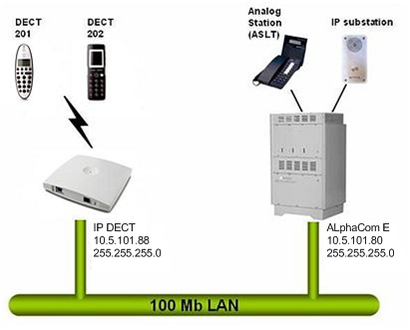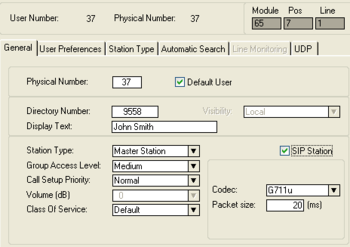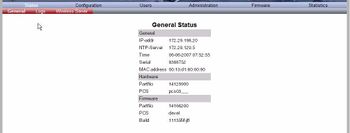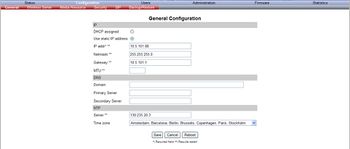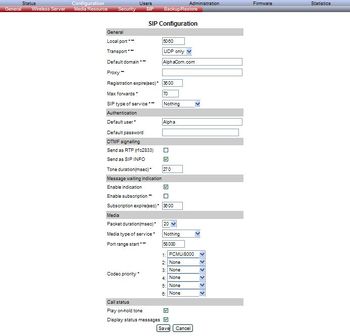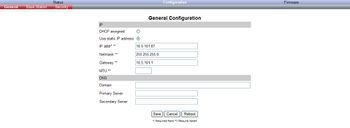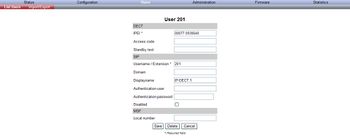Difference between revisions of "IP-DECT server 6000"
From Zenitel Wiki
(→Wireless Server Configuration) |
|||
| (97 intermediate revisions by 2 users not shown) | |||
| Line 1: | Line 1: | ||
| − | This article describes how to setup the STENTOFON | + | {{A}} |
| − | [[Image:STENTOFON IP DECT Configuration Example.JPG|thumb|350px| | + | |
| + | {{obsolete}} | ||
| + | |||
| + | {{Note| Zenitel (Stentofon) does not provide any DECT product anymore. The information in this article may be outdated!}} | ||
| + | |||
| + | This article describes how to setup the STENTOFON IP DECT Server 6000 to work with the AlphaCom E using the SIP protocol. | ||
| + | [[Image:STENTOFON IP DECT Configuration Example.JPG|thumb|410px|Configuration example]] | ||
| + | |||
| + | ==Configuration of AlphaCom XE== | ||
| + | How to configure the AlphaCom XE depends on the software version in the AMC-IP board. | ||
| + | |||
| + | Also see: [[SIP phone as station]] | ||
| + | |||
| + | === AMC 10.56 and newer === | ||
| + | [[Image:SIP phone as station.png|left|350px|thumb|SIP phones are configured in the Users & Stations window]] | ||
<br style="clear:both;" /> | <br style="clear:both;" /> | ||
| + | * AlphaPro software 10.56. or newer is required for the configuration | ||
| + | * From the '''Users & Stations''' window in AlphaPro, select a user and enable the 'SIP station' flag | ||
| + | * Configure Directory number and Display text | ||
| + | * Select a supported codec for the SIP station to use | ||
| − | == | + | === AMC 10.55 and earlier === |
The AlphaCom E needs to be configured with a [[SIP registrar node - configuration|SIP registrar node]], and must be equipped with [[Licenses#SIP_station_license|license for SIP stations]]. | The AlphaCom E needs to be configured with a [[SIP registrar node - configuration|SIP registrar node]], and must be equipped with [[Licenses#SIP_station_license|license for SIP stations]]. | ||
| − | |||
==Configuration of STENTOFON IP-DECT== | ==Configuration of STENTOFON IP-DECT== | ||
=== Getting access to the embedded web server=== | === Getting access to the embedded web server=== | ||
| − | + | Load factory default configuration on the IP-Dect Server by pressing the reset button through the hole at the rear with an unbend paper clip for 10 sec. Observe the front LED; when pressing the reset button the LED becomes steady red for about 5 seconds, it then starts to flash slowly. When releasing the reset button after 10 seconds, the LED starts to flash fast, colored red. It finally turns off (the server is rebooting). | |
| − | |||
| − | Load factory default configuration on the IP-Dect Server by pressing the reset button through the hole at the rear with an unbend paper clip for 10 sec. | ||
Before the PC can access the IP Dect Server, the IP address of the PC must be changed to match the same subnet (for example 192.168.0.2). | Before the PC can access the IP Dect Server, the IP address of the PC must be changed to match the same subnet (for example 192.168.0.2). | ||
| Line 20: | Line 35: | ||
:Password: ip6000 | :Password: ip6000 | ||
| − | The GENERAL STATUS page should now be displayed: | + | The GENERAL STATUS page should now be displayed. |
| − | + | [[Image:DECT - General Status.JPG|left|thumb|350px|GENERAL STATUS page - Logged on to IP address 192.168.0.1]] | |
| − | <br | + | <br style="clear:both;" /> |
===General Configuration=== | ===General Configuration=== | ||
| − | |||
| − | |||
''All changes to fields marked with two stars need a reboot to take effect''<br/> | ''All changes to fields marked with two stars need a reboot to take effect''<br/> | ||
On the General Configuration page you define IP and NTP settings for the STENTOFON IP-DECT Server 6000. | On the General Configuration page you define IP and NTP settings for the STENTOFON IP-DECT Server 6000. | ||
| − | + | #Click Configuration, and then click General. | |
| − | + | #Click Use Static IP Address. | |
| − | + | #In the IP Addr field, type in the IP address of the IP-DECT Server. | |
| − | + | #In the Netmask field, type in the network mask. | |
| − | + | #In the Gateway field, type in the IP address of the default gateway. | |
| − | + | #In the Server field (under NTP - Network Time Protocol), type the IP address of the NTP server from which the system will obtain the current time (optional). | |
| − | + | #From the Time Zone list, select the wanted time zone (optional). | |
| − | + | #Click Save. | |
| − | + | #Click Reboot. You need to change your computers IP address to match your new address in the server in order to enter the configuration again. | |
| − | Leave the rest | + | Leave the rest to default settings. |
| + | [[Image:DECT - General Configuration.JPG|left|thumb|350px|General Configuraion]] | ||
| + | <br style="clear:both;" /> | ||
===Wireless Server Configuration=== | ===Wireless Server Configuration=== | ||
| − | + | ''All changes in fields marked with two stars need a reboot to take effect''<br/> | |
| − | |||
| − | ''All changes | ||
On the Configuration/Wireless Server page you configure the STENTOFON IP-DECT Server 6000 to allow subscriptions. If the system does not allow subscription, it is not possible to subscribe a handset. | On the Configuration/Wireless Server page you configure the STENTOFON IP-DECT Server 6000 to allow subscriptions. If the system does not allow subscription, it is not possible to subscribe a handset. | ||
| − | + | #Click Configuration, and then click Wireless Server. | |
| − | + | #Select the Subscription Allowed check box (optional). | |
| − | + | ## ''Note: If not selected, you cannot subscribe a handset.'' | |
| − | + | #Click Save. | |
| + | [[Image:DECT - Wireless Server Configuration.JPG|left|thumb|350px|Wireless Server Configuration]] | ||
| + | <br style="clear:both;" /> | ||
===Built-In Media Resource Configuration=== | ===Built-In Media Resource Configuration=== | ||
''All changes to fields marked with two stars need a reboot to take effect''<br/> | ''All changes to fields marked with two stars need a reboot to take effect''<br/> | ||
On the Configuration/Media Resource page you configure the built-in Media Resource. | On the Configuration/Media Resource page you configure the built-in Media Resource. | ||
| − | |||
| − | |||
| − | |||
| − | |||
| − | |||
| + | #Click Configuration, and then click Media Resource. | ||
| + | #In the Host field, type localhost to activate the built-in media resource. | ||
| + | #Click Save. | ||
| + | [[Image:DECT - Media Resource Configuration.JPG|left|thumb|350px|Media Resource Configuration]] | ||
<br style="clear:both;" /> | <br style="clear:both;" /> | ||
| Line 67: | Line 81: | ||
On the Configuration/SIP page you define general SIP settings, information about authentication, DTMF signalling, message waiting indication and | On the Configuration/SIP page you define general SIP settings, information about authentication, DTMF signalling, message waiting indication and | ||
media. | media. | ||
| − | |||
| − | + | #Click Configuration, and then click SIP. | |
| − | + | #In the '''Local Port''' field, type the local port number. The default local port number is 5060. | |
| − | + | #In the '''Default Domain''' field, type the name of the domain. For example '''Stentofon.com'''. | |
| − | + | #In the '''Proxy''' field, type in the IP address of your AlphaCom. | |
| − | + | #In the '''Default User''' field, type the user name. For example "'''Alpha'''" | |
| − | + | #In the '''Default Password''' field, type the password. For example "'''com'''". | |
| − | + | #Select the '''Send as SIP INFO''' check box if you want the keypad signalling sent as SIP INFO packets with DTMF code. | |
| − | + | #From the Packet Duration(msec) list, select 20. | |
| − | + | #In the Codec priority fields, select PCMU/8000 for field number 1. | |
| − | + | ##Set the rest to "None". | |
| − | + | #Click Save to save your SIP configuration data. | |
| − | + | #Go to the Configuration/General page and click Reboot to make all the changes take effect. | |
| + | Leave the rest to default settings. | ||
| + | |||
| + | [[Image:DECT - SIP Configuration.JPG|left|thumb|350px|SIP Configuration]] | ||
<br style="clear:both;" /> | <br style="clear:both;" /> | ||
| Line 88: | Line 104: | ||
===Powering up the Base Station=== | ===Powering up the Base Station=== | ||
After installing the base station you need to power it up. The base station uses: | After installing the base station you need to power it up. The base station uses: | ||
| − | + | * Power over Ethernet (PoE 802.3af). | |
| − | + | * Maximum power supply consumption is 3.0W (IEEE 802.3af class 1 device). | |
Use a standard PoE adapter or a PoE-enabled port on a switch adhering to PoE 802.3af when connecting the base station to a PoE power source. | Use a standard PoE adapter or a PoE-enabled port on a switch adhering to PoE 802.3af when connecting the base station to a PoE power source. | ||
===Accessing the Web Based Administration Page=== | ===Accessing the Web Based Administration Page=== | ||
| + | Load the Base Station factory default, in the same way as for the STENTOFON IP DECT Server 6000. <br/> | ||
In order for your computer to communicate with the base station it is necessary to change the computer’s Internet Protocol Properties to use the | In order for your computer to communicate with the base station it is necessary to change the computer’s Internet Protocol Properties to use the | ||
following: | following: | ||
| − | + | * IP address: 192.168.0.2 | |
| − | + | * Sub-net mask: 255.255.255.0 | |
The web based Administration Page is accessed through a standard web browser. | The web based Administration Page is accessed through a standard web browser. | ||
| − | + | #Open a web browser. | |
| − | + | #In the browsers Address bar, type 192.168.0.1, and then press ENTER. | |
| − | + | ##''Note: The base station is pre-configured with the IP address: 192.168.0.1 through the ETH port.'' | |
The Administration Page for the base station appears. First time you access the Administration Page, you need to log on with user name and a password. | The Administration Page for the base station appears. First time you access the Administration Page, you need to log on with user name and a password. | ||
Default: | Default: | ||
| Line 111: | Line 128: | ||
====General Configuration==== | ====General Configuration==== | ||
| − | On the General Configuration page you define IP | + | On the General Configuration page you define IP settings for the base station. |
| − | + | #Click Configuration, and then click General. | |
| − | + | #Click '''Use static IP address'''. | |
| − | + | #In the '''IP addr''' field, type the IP address of the base station. | |
| − | + | #In the '''Netmask field''', type the network mask. | |
| − | + | #In the '''Gateway field''', type the IP address of the default gateway (optional). | |
| − | + | #Click Save. | |
| − | + | ||
| − | + | Leave the rest to default settings. <br/> | |
| − | + | [[Image:DECT - Base General Configuration.JPG|left|thumb|350px|Base Station - General Configuration]] | |
| + | <br style="clear:both;" /> | ||
| + | |||
| + | '''''Note:''' If your network supports DHCP, select '''DHCP assigned''' in stead of '''Use static IP address''''' | ||
====Base Station Configuration==== | ====Base Station Configuration==== | ||
How to configure the base station: | How to configure the base station: | ||
| − | + | #Click Configuration, and then click Base station. | |
| − | + | #In the '''Host''' field, type the host name or the IP address of the IP-DECT Server 6000. | |
| − | + | #Click Save. | |
| − | + | #Click Reboot to enable the configuration changes. | |
| − | + | [[Image:DECT - Base Station Configuration.JPG|left|thumb|350px|Base Station Configuration]] | |
| − | + | <br style="clear:both;" /> | |
| − | |||
| − | |||
| − | |||
| − | |||
| − | |||
| − | |||
| − | |||
| − | |||
| − | |||
| − | |||
| − | |||
| − | |||
| − | |||
| − | |||
| − | |||
| − | + | ===Checking Indicators=== | |
Verify that the base station LED indicator is continuously on, indicating that the base station is functional. | Verify that the base station LED indicator is continuously on, indicating that the base station is functional. | ||
==Handset Registration and Subscription== | ==Handset Registration and Subscription== | ||
This section provides information about handset registration and subscription. You must register and subscribe a handset before you can use it. | This section provides information about handset registration and subscription. You must register and subscribe a handset before you can use it. | ||
| − | When registering handsets you enter information about the | + | |
| + | When registering handsets you enter information about the handset settings (such as; the handset serial number (IPEI), name etc.) in the system database. When subscribing handsets you subscribe a registered handset to the system for usage. If the handset is not registered in the system database, subscription of the handset is not possible. | ||
===Registering IP-DECT Handsets=== | ===Registering IP-DECT Handsets=== | ||
To register handsets you use the web based Administration Page of the STENTOFON IP-DECT Server 6000. | To register handsets you use the web based Administration Page of the STENTOFON IP-DECT Server 6000. | ||
| − | |||
| − | + | Each handset in the wireless solution must be programmed with the serial number (IPEI) before it can operate. This serial number must be registered in the web based Administration Page of the IP-DECT Server. Serial numbers are a unique fingerprint of each handset. The serial number is programmed into the handset during the manufacturing process and cannot be changed by field personnel. The serial number can be found on a label beneath the battery or it can be viewed in the handsets display. | |
| − | + | * For Rough and EX handsets: press '''*99984*V''' | |
| − | + | * For Office handsets: press '''Menu''', '''Status''', '''Firmware version'''. | |
| − | + | ''The Serial number consists of 12 digits and always starts with '''00077''' | |
| − | |||
| − | |||
| − | |||
| − | |||
| − | |||
| − | |||
| − | |||
| − | |||
| − | |||
| − | |||
| − | |||
| − | |||
| − | |||
| − | |||
| − | |||
| − | |||
| − | |||
| − | |||
| − | |||
| − | + | Log in to the IP DECT Server 6000 and go to the Administration/Users page. | |
| − | + | #Click Users and then click List Users. | |
| − | + | #Click New. | |
| − | + | #In the '''IPEI''' field, type the '''IPEI number''' (serial number) of the handset. | |
| − | + | #In the '''Username/Extension''' field, type the Global User number configured in the AlphaCom. | |
| − | + | #In the '''Domain''' field, type the Domain used in your system, for example '''Stentofon.com''' | |
| − | + | #In the '''Displayname field''', type the name to be displayed (caller ID). | |
| − | + | #Click Save to save the registration(s). | |
| − | + | [[Image:DECT - User Registration.JPG|left|thumb|350px|Registering Users]] | |
| − | + | <br style="clear:both;" /> | |
| − | + | Leave the rest to default settings. | |
| − | |||
| − | |||
| − | |||
| − | |||
| − | |||
| − | |||
| − | |||
| − | |||
| − | |||
| − | |||
| − | |||
| − | |||
| − | |||
| − | |||
| − | |||
| − | |||
| − | |||
| − | |||
| − | |||
| − | |||
| − | |||
| − | |||
| − | |||
| − | |||
| − | |||
| − | |||
| − | |||
| − | |||
| − | |||
| − | |||
| − | |||
| − | |||
| − | |||
| − | ''' | + | ====Subscribing Rough and EX Handsets==== |
| − | + | #Press '''MENU''' - go to '''MENU LOGIN'''. | |
| − | + | #Press '''V''' - go to '''SUBSCRIPTION CREATE''' to subscribe to a system. | |
| − | + | #Press '''V'''. The handset searches for the serial number of the system. | |
| − | + | #When the serial number of the system appears in the display, press '''V'''. | |
| − | + | An antenna symbol appears on the display to indicate a successful subscription. If not, the subscription has failed and the procedure must be retried. | |
| − | ''' | + | ====Subscribing Office Handsets==== |
| − | + | #Press '''Menu''' to enter main menu. | |
| − | + | #Scroll to '''Settings''' and press '''Select'''. | |
| − | + | #Scroll to '''Advanced''' and press '''Select'''. | |
| − | + | #Scroll to '''Login''' and press '''Select'''. | |
| − | + | #Scroll to '''Create login''' and press '''Select'''. The handset will start searching for a system. | |
| − | + | #Scroll to the found system and press '''Select'''. | |
| − | + | #Press '''Ok'''. | |
| − | ==== | + | ==LED Indicator== |
| − | + | {| border="1" | |
| − | + | ! style="background:#ffdead;" width="100" | ''LED Indicator:'' | |
| − | + | ! style="background:#ffdead;" width="350" |''Meaning'' | |
| − | + | |- | |
| − | + | | align=left | Steady Green || align=left | OK and idle | |
| − | + | |- | |
| − | + | | align=left | Slow Green Flashing || align=left | OK and active voice call | |
| − | + | |- | |
| + | | align=left | Fast Green Flashing || align=left | Active, in operation with maximum active connections (busy) | ||
| + | |- | ||
| + | | align=left | Slow Red Flashing || align=left | Missing Base Station | ||
| + | |- | ||
| + | | align=left | Fast Red Flashing || align=left | Error | ||
| + | |- | ||
| + | | align=left | Steady Red || align=left | Reset/Shutdown in progress | ||
| + | |- | ||
| + | | align=left | Steady Red for seconds followed by fast red flashing || align=left | Reset to factory settings | ||
| + | |- | ||
| + | |} | ||
| − | == | + | ==Reset== |
| − | + | This section contains a description of the different actions that occur when the Reset Button is pressed: | |
| − | + | Short press (2-5 sec) - System restarts when button is released. | |
| − | |||
| − | 2 | ||
| − | |||
| − | |||
| − | |||
| − | |||
| − | |||
| − | |||
| − | + | Long press (5-9 sec) Resets the system to factory default settings | |
| − | + | until front LED flashes red, - (original IP settings and empty user data base) | |
| − | + | then release button and restarts the system. Firmware version is not affected. | |
| − | |||
| − | |||
| − | |||
| − | |||
| − | |||
| − | |||
| − | |||
| − | [[Category: | + | [[Category:Discontinued Accessories]] |
Latest revision as of 16:01, 8 November 2021

|
Zenitel (Stentofon) does not provide any DECT product anymore. The information in this article may be outdated! |
This article describes how to setup the STENTOFON IP DECT Server 6000 to work with the AlphaCom E using the SIP protocol.
Contents
Configuration of AlphaCom XE
How to configure the AlphaCom XE depends on the software version in the AMC-IP board.
Also see: SIP phone as station
AMC 10.56 and newer
- AlphaPro software 10.56. or newer is required for the configuration
- From the Users & Stations window in AlphaPro, select a user and enable the 'SIP station' flag
- Configure Directory number and Display text
- Select a supported codec for the SIP station to use
AMC 10.55 and earlier
The AlphaCom E needs to be configured with a SIP registrar node, and must be equipped with license for SIP stations.
Configuration of STENTOFON IP-DECT
Getting access to the embedded web server
Load factory default configuration on the IP-Dect Server by pressing the reset button through the hole at the rear with an unbend paper clip for 10 sec. Observe the front LED; when pressing the reset button the LED becomes steady red for about 5 seconds, it then starts to flash slowly. When releasing the reset button after 10 seconds, the LED starts to flash fast, colored red. It finally turns off (the server is rebooting).
Before the PC can access the IP Dect Server, the IP address of the PC must be changed to match the same subnet (for example 192.168.0.2).
To access the embedded web server of the IP-Dect Server, start your internet browser (e.g. Internet Explorer) and in the address field enter 192.168.0.1. You will be prompted for a username and password. Default: admin and ip6000 (case senstive).
Default:
- Username: admin
- Password: ip6000
The GENERAL STATUS page should now be displayed.
General Configuration
All changes to fields marked with two stars need a reboot to take effect
On the General Configuration page you define IP and NTP settings for the STENTOFON IP-DECT Server 6000.
- Click Configuration, and then click General.
- Click Use Static IP Address.
- In the IP Addr field, type in the IP address of the IP-DECT Server.
- In the Netmask field, type in the network mask.
- In the Gateway field, type in the IP address of the default gateway.
- In the Server field (under NTP - Network Time Protocol), type the IP address of the NTP server from which the system will obtain the current time (optional).
- From the Time Zone list, select the wanted time zone (optional).
- Click Save.
- Click Reboot. You need to change your computers IP address to match your new address in the server in order to enter the configuration again.
Leave the rest to default settings.
Wireless Server Configuration
All changes in fields marked with two stars need a reboot to take effect
On the Configuration/Wireless Server page you configure the STENTOFON IP-DECT Server 6000 to allow subscriptions. If the system does not allow subscription, it is not possible to subscribe a handset.
- Click Configuration, and then click Wireless Server.
- Select the Subscription Allowed check box (optional).
- Note: If not selected, you cannot subscribe a handset.
- Click Save.
Built-In Media Resource Configuration
All changes to fields marked with two stars need a reboot to take effect
On the Configuration/Media Resource page you configure the built-in Media Resource.
- Click Configuration, and then click Media Resource.
- In the Host field, type localhost to activate the built-in media resource.
- Click Save.
IP-DECT Server 6000 SIP Configuration
All changes to fields marked with two stars need a reboot to take effect
On the Configuration/SIP page you define general SIP settings, information about authentication, DTMF signalling, message waiting indication and
media.
- Click Configuration, and then click SIP.
- In the Local Port field, type the local port number. The default local port number is 5060.
- In the Default Domain field, type the name of the domain. For example Stentofon.com.
- In the Proxy field, type in the IP address of your AlphaCom.
- In the Default User field, type the user name. For example "Alpha"
- In the Default Password field, type the password. For example "com".
- Select the Send as SIP INFO check box if you want the keypad signalling sent as SIP INFO packets with DTMF code.
- From the Packet Duration(msec) list, select 20.
- In the Codec priority fields, select PCMU/8000 for field number 1.
- Set the rest to "None".
- Click Save to save your SIP configuration data.
- Go to the Configuration/General page and click Reboot to make all the changes take effect.
Leave the rest to default settings.
Base Station Configuration
Powering up the Base Station
After installing the base station you need to power it up. The base station uses:
- Power over Ethernet (PoE 802.3af).
- Maximum power supply consumption is 3.0W (IEEE 802.3af class 1 device).
Use a standard PoE adapter or a PoE-enabled port on a switch adhering to PoE 802.3af when connecting the base station to a PoE power source.
Accessing the Web Based Administration Page
Load the Base Station factory default, in the same way as for the STENTOFON IP DECT Server 6000.
In order for your computer to communicate with the base station it is necessary to change the computer’s Internet Protocol Properties to use the
following:
- IP address: 192.168.0.2
- Sub-net mask: 255.255.255.0
The web based Administration Page is accessed through a standard web browser.
- Open a web browser.
- In the browsers Address bar, type 192.168.0.1, and then press ENTER.
- Note: The base station is pre-configured with the IP address: 192.168.0.1 through the ETH port.
The Administration Page for the base station appears. First time you access the Administration Page, you need to log on with user name and a password. Default:
- Username: admin
- Password: ip6000
Configuring a Base Station Using Static IP Address
This section describes how to configure a base station using static IP address.
General Configuration
On the General Configuration page you define IP settings for the base station.
- Click Configuration, and then click General.
- Click Use static IP address.
- In the IP addr field, type the IP address of the base station.
- In the Netmask field, type the network mask.
- In the Gateway field, type the IP address of the default gateway (optional).
- Click Save.
Leave the rest to default settings.
Note: If your network supports DHCP, select DHCP assigned in stead of Use static IP address
Base Station Configuration
How to configure the base station:
- Click Configuration, and then click Base station.
- In the Host field, type the host name or the IP address of the IP-DECT Server 6000.
- Click Save.
- Click Reboot to enable the configuration changes.
Checking Indicators
Verify that the base station LED indicator is continuously on, indicating that the base station is functional.
Handset Registration and Subscription
This section provides information about handset registration and subscription. You must register and subscribe a handset before you can use it.
When registering handsets you enter information about the handset settings (such as; the handset serial number (IPEI), name etc.) in the system database. When subscribing handsets you subscribe a registered handset to the system for usage. If the handset is not registered in the system database, subscription of the handset is not possible.
Registering IP-DECT Handsets
To register handsets you use the web based Administration Page of the STENTOFON IP-DECT Server 6000.
Each handset in the wireless solution must be programmed with the serial number (IPEI) before it can operate. This serial number must be registered in the web based Administration Page of the IP-DECT Server. Serial numbers are a unique fingerprint of each handset. The serial number is programmed into the handset during the manufacturing process and cannot be changed by field personnel. The serial number can be found on a label beneath the battery or it can be viewed in the handsets display.
- For Rough and EX handsets: press *99984*V
- For Office handsets: press Menu, Status, Firmware version.
The Serial number consists of 12 digits and always starts with 00077
Log in to the IP DECT Server 6000 and go to the Administration/Users page.
- Click Users and then click List Users.
- Click New.
- In the IPEI field, type the IPEI number (serial number) of the handset.
- In the Username/Extension field, type the Global User number configured in the AlphaCom.
- In the Domain field, type the Domain used in your system, for example Stentofon.com
- In the Displayname field, type the name to be displayed (caller ID).
- Click Save to save the registration(s).
Leave the rest to default settings.
Subscribing Rough and EX Handsets
- Press MENU - go to MENU LOGIN.
- Press V - go to SUBSCRIPTION CREATE to subscribe to a system.
- Press V. The handset searches for the serial number of the system.
- When the serial number of the system appears in the display, press V.
An antenna symbol appears on the display to indicate a successful subscription. If not, the subscription has failed and the procedure must be retried.
Subscribing Office Handsets
- Press Menu to enter main menu.
- Scroll to Settings and press Select.
- Scroll to Advanced and press Select.
- Scroll to Login and press Select.
- Scroll to Create login and press Select. The handset will start searching for a system.
- Scroll to the found system and press Select.
- Press Ok.
LED Indicator
| LED Indicator: | Meaning |
|---|---|
| Steady Green | OK and idle |
| Slow Green Flashing | OK and active voice call |
| Fast Green Flashing | Active, in operation with maximum active connections (busy) |
| Slow Red Flashing | Missing Base Station |
| Fast Red Flashing | Error |
| Steady Red | Reset/Shutdown in progress |
| Steady Red for seconds followed by fast red flashing | Reset to factory settings |
Reset
This section contains a description of the different actions that occur when the Reset Button is pressed:
Short press (2-5 sec) - System restarts when button is released.
Long press (5-9 sec) Resets the system to factory default settings until front LED flashes red, - (original IP settings and empty user data base) then release button and restarts the system. Firmware version is not affected.


